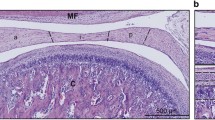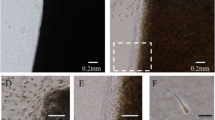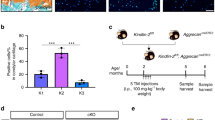Abstract
We examined the localization and boundary lubricating function of superficial zone protein (SZP) on the surface of mandibular condylar cartilage. Chondrocytes were separated from the surface layer of mandibular condylar cartilage of 6- to 9-month-old female pigs. A cyclic tensile strain of 7% or 21% cell elongation was applied to the cultured chondrocytes. Gene expression levels of cartilage matrix proteins and secretory phospholipase A2 (sPLA2) were quantified by real-time polymerase chain reaction analysis. The friction coefficient of the mandibular condylar surface was measured by a friction tester before and after treatment with 0.1 U/ml sPLA2. Significantly higher mRNA levels of SZP and type I collagen were found in chondrocytes from the superficial layer than in those in the other layers. The SZP mRNA level was up-regulated by cyclic tensile strain of 7% and 21% cell elongation. Cyclic tensile strain of 21% cell elongation up-regulated the sPLA2 mRNA level. The friction coefficient of the condylar surface was increased significantly by treatment with sPLA2. The removal of SZP from the surface layer of mandibular condylar cartilage by sPLA2 resulted in a significant increase in the friction coefficient on the surface of articular cartilage.





Similar content being viewed by others
References
Astapenko MG, Fil'chagin NM, Duliapin VA, Mazina NM, Sysoev VF (1979) Structural and metabolic changes in the articular cartilage in the early stage of primary osteoarthrosis deformans. Vopr Revm 4:8–14
Banes AJ, Link GW Jr, Gilbert JW, Tran Son Tay R, Monbureau O (1990) Culturing cells in a mechanically active environment. Am Biotechnol Lab 8:12–22
Chan SM, Neu CP, Duraine G, Komvopoulos K, Reddi AH (2010) Atomic force microscope investigation of the boundary-lubricant layer in articular cartilage. Osteoarthritis Cartilage 18:956–963
Flannery CR, Hughes CE, Schumacher BL, Tudor D, Aydelotte MB, Kuettner KE, Caterson B (1999) Articular cartilage superficial zone protein (SZP) is homologous to megakaryocyte stimulating factor precursor and is a multifunctional proteoglycan with potential growth-promoting, cytoprotective, and lubricating properties in cartilage metabolism. Biochem Biophys Res Commun 254:535–541
Ghosh P, Hutadilok N, Adam N, Lentini A (1994) Interactions of hyaluronan (hyaluronic acid) with phospholipids as determined by gel permeation chromatography, multi-angle laser-light-scattering photometry and 1 H-NMR spectroscopy. Int J Biol Macromol 16:237–244
Grad S, Lee CR, Gorna K, Gogolewski S, Wimmer MA, Alini M (2005) Surface motion upregulates superficial zone protein and hyaluronan production in chondrocyte-seeded three-dimensional scaffolds. Tissue Eng 11:249–256
Hauselmann HJ, Flechtenmacher J, Michal L, Thonar EJ, Shinmei M, Kuettner KE, Aydelotte MB (1996) The superficial layer of human articular cartilage is more susceptible to interleukin-1-induced damage than the deeper layers. Arthritis Rheum 39:478–488
Hidaka C, Cheng C, Alexandre D, Bhargava M, Torzilli PA (2006) Maturational differences in superficial and deep zone articular chondrocytes. Cell Tissue Res 323:127–135
Hills BA, Monds MK (1998) Enzymatic identification of the load-bearing boundary lubricant in the joint. Br J Rheumatol 37:137–142
Hirschmann PN, Shuttleworth CA (1976) The collagen composition of the mandibular joint of the foetal calf. Arch Oral Biol 21:771–773
Honda K, Ohno S, Tanimoto K, Ijuin C, Tanaka N, Doi T, Kato Y, Tanne K (2000) The effects of high magnitude cyclic tensile load on cartilage matrix metabolism in cultured chondrocytes. Eur J Cell Biol 79:601–609
Jay GD, Lane BP, Sokoloff L (1992) Characterization of a bovine synovial fluid lubricating factor. III. The interaction with hyaluronic acid. Connect Tissue Res 28:245–255
Jay GD, Torres JR, Rhee DK, Helminen HJ, Hytinnen MM, Cha CJ, Elsaid K, Kim KS, Cui Y, Warman ML (2007) Association between friction and wear in diarthrodial joints lacking lubricin. Arthritis Rheum 56:3662–3669
Kawai N, Tanaka E, Takata T, Miyauchi M, Tanaka M, Todoh M, Eijden T van, Tanne K (2004) Influence of additive hyaluronic acid on the lubricating ability in the temporomandibular joint. J Biomed Mater Res A 70:149–153
Little T, Freeman M, Swanson A (1969) Experiments on friction in the human hip joint. In: Wright V (ed) Lubrication and wear in joints. Sector, London, pp 110–114
Livne E, Laufer D, Blumenfeld I (1997) Osteoarthritis in the temporo-mandibular joint (TMJ) of aged mice and the in vitro effect of TGF-beta 1 on cell proliferation, matrix synthesis, and alkaline phosphatase activity. Microsc Res Tech 37:314–323
Lyons-Giordano B, Pratta MA, Galbraith W, Davis GL, Arner EC (1993) Interleukin-1 differentially modulates chondrocyte expression of cyclooxygenase-2 and phospholipase A2. Exp Cell Res 206:58–62
Marcelino J, Carpten JD, Suwairi WM, Gutierrez OM, Schwartz S, Robbins C, Sood R, Makalowska I, Baxevanis A, Johnstone B, Laxer RM, Zemel L, Kim CA, Herd JK, Ihle J, Williams C, Johnson M, Raman V, Alonso LG, Brunoni D, Gerstein A, Papadopoulos N, Bahabri SA, Trent JM, Warman ML (1999) CACP, encoding a secreted proteoglycan, is mutated in camptodactyly-arthropathy-coxa vara-pericarditis syndrome. Nat Genet 23:319–322
Mawatari T, Lindsey DP, Harris AH, Goodman SB, Maloney WJ, Smith RL (2010) Effects of tensile strain and fluid flow on osteoarthritic human chondrocyte metabolism in vitro. J Orthop Res 28:907–913
Murakami M, Kudo I (2002) Phospholipase A2. J Biochem 131:285–292
Nickel JC, McLachlan KR (1994) In vitro measurement of the frictional properties of the temporomandibular joint disc. Arch Oral Biol 39:323–331
Nitzan DW, Nitzan U, Dan P, Yedgar S (2001) The role of hyaluronic acid in protecting surface-active phospholipids from lysis by exogenous phospholipase A(2). Rheumatology (Oxford) 40:336–340
Nugent GE, Aneloski NM, Schmidt TA, Schumacher BL, Voegtline MS, Sah RL (2006) Dynamic shear stimulation of bovine cartilage biosynthesis of proteoglycan 4. Arthritis Rheum 54:1888–1896
Ohno S, Schmid T, Tanne Y, Kamiya T, Honda K, Ohno-Nakahara M, Swentko N, Desai TA, Tanne K, Knudson CB, Knudson W (2006) Expression of superficial zone protein in mandibular condyle cartilage. Osteoarthritis Cartilage 14:807–813
Pruzanski W, Vadas P (1991) Phospholipase A2—a mediator between proximal and distal effectors of inflammation. Immunol Today 12:143–146
Pruzanski W, Bogoch E, Wloch M, Vadas P (1991) The role of phospholipase A2 in the physiopathology of osteoarthritis. J Rheumatol Suppl 27:117–119
Rahamim E, Better H, Dagan A, Nitzan DW (2001) Electron microscope and biochemical observations of the surface active phospholipids on the articular surfaces and in the synovial fluid of the temporomandibular joint: a preliminary investigation. J Oral Maxillofac Surg 59:1326–1332
Rainer F, Ribitsch V (1985) Viscoelastic properties of normal human synovia and their relation to biomechanics. Z Rheumatol 44:114–119
Rees SG, Davies JR, Tudor D, Flannery CR, Hughes CE, Dent CM, Caterson B (2002) Immunolocalisation and expression of proteoglycan 4 (cartilage superficial zone proteoglycan) in tendon. Matrix Biol 21:593–602
Sarma AV, Powell GL, LaBerge M (2001) Phospholipid composition of articular cartilage boundary lubricant. J Orthop Res 19:671–676
Schumacher BL, Block JA, Schmid TM, Aydelotte MB, Kuettner KE (1994) A novel proteoglycan synthesized and secreted by chondrocytes of the superficial zone of articular cartilage. Arch Biochem Biophys 311:144–152
Schwarz IM, Hills BA (1998) Surface-active phospholipid as the lubricating component of lubricin. Br J Rheumatol 37:21–26
Smith MM, Ghosh P (1987) The synthesis of hyaluronic acid by human synovial fibroblasts is influenced by the nature of the hyaluronate in the extracellular environment. Rheumatol Int 7:113–122
Tanaka E, Tanne K, Sakuda M (1994) A three-dimensional finite element model of the mandible including the TMJ and its application to stress analysis in the TMJ during clenching. Med Eng Phys 16:316–322
Vignon E, Mathieu P, Louisot P, Vilamitjana J, Harmand MF, Richard M (1989) Phospholipase A2 activity in human osteoarthritic cartilage. J Rheumatol Suppl 18:35–38
Wei L, Xiong H, Li B, Cheng Y, Long X (2010) Boundary-lubricating ability and lubricin in synovial fluid of patients with temporomandibular joint disorders. J Oral Maxillofac Surg 68:2478–2483
Author information
Authors and Affiliations
Corresponding author
Additional information
This research was supported by a Grant-in-Aid (no. 20390523) for Scientific Research from the Ministry of Education, Culture, Sports, Science, and Technology, Japan.
Rights and permissions
About this article
Cite this article
Tanimoto, K., Kamiya, T., Tanne, Y. et al. Superficial zone protein affects boundary lubrication on the surface of mandibular condylar cartilage. Cell Tissue Res 344, 333–340 (2011). https://doi.org/10.1007/s00441-011-1156-z
Received:
Accepted:
Published:
Issue Date:
DOI: https://doi.org/10.1007/s00441-011-1156-z




